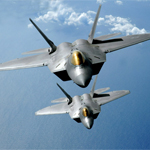Could the F-22’s skin be the problem?

The Air Force says its F-22 Raptor brings something to the battle that no other U.S. jet fighter can match: Its ability to evade radar through stealth technology. But now critics are offering up a troubling hypothesis: Could the very materials that make the Raptor stealthy be contributing to problems of dizziness and disorientation that some pilots have experienced in the cockpit? Air Force investigators are looking into the possibility that toxic substances are infiltrating the pilot’s air supply. That’s one of their main theories. The other is that pilots are simply not getting enough oxygen.
Pierre Sprey, who was heavily involved in the design of the F-16 fighter and has been critical of the F-22, noted many possible sources for toxic fumes on a jet like the Raptor, such as hydraulic fluid or overheated plastics.
His belief that stealth coatings play a role is based on anecdotes that seem unique to the F-22 — the so-called “Raptor cough” and feelings of disorientation that persist well after a mission ends. He recently outlined his views in an article co-authored with Dina Rasor, an investigator and author who founded the Bauman and Rasor Group, which helps whistleblowers file lawsuits under federal law.
Sprey said if those symptoms are unique to Raptor pilots, perhaps it’s connected to what is unique about the Raptor itself: The stealth material, which contains layers bonded together with noxious adhesives.
It is a “very, very serious problem if materials in the Raptor skin are generating vapors at levels high enough to cause a pilot to feel dizzy, he said.
“By the time it gets high enough to give you something like hypoxia, you’ve really had a snootful,” he said.
Sen. Mark R. Warner has heard from several Raptor pilots and Air Force flight surgeons who have confided their concerns about the fighter. The idea that the stealth coatings could be source of toxins is one of the theories coming “from credible people,” said Warner spokesman Kevin Hall.
No evidence
The Air Force says there is no clinical evidence that the Raptor is making pilots sick, and it has other explanations for the persistent cough and disorientation that, in a few cases, lasts beyond the end of the mission.
Meanwhile, it continues to investigate 11 unexplained incidents of hypoxia that have occurred since September, when the aircraft returned to the skies after a four-month stand-down. Earlier hypoxia incidents had prompted the stand-down, and the Air Force lifted it without determining the root cause of the problem, although it enacted additional safety measures and vowed to monitor the condition of pilots.
Investigators now believe that the 11 incidents might be caused by several factors that could be interconnected in some way, according to Brig Gen. Daniel Wyman, the Air Combat Command surgeon general.
“It may be part of their operating environment,” he recently told reporters. “It may be part of the systems we have in place in the aircraft to protect them. It may be part of some potential contaminant. It may be all of those. We continue to look at that. But the manifestations are all physiologic.”
Raptor cough
F-22 pilots breathe in high concentrations of oxygen while experiencing high G forces during flight. It prevents them from passing out during intense pressure that literally multiplies their body weight. Inhaling oxygen-rich air can cause “micro-collapse” of smaller air sacs in the lungs, and coughing is a natural response to re-inflate them, Wyman said.
Wyman said the cough occurs more frequently in F-22 pilots than in the earlier F-15s or F-16s. Many F-22 pilots used to fly those older jets, so they have some basis for comparison. The cough may relate to the expanded capabilities of the Raptor.
“The flight envelope of the F-22 is significantly different than the other fighters,” he said, “and this may contribute to this cough, but we are continuing to evaluate it with our pilots.”
Lingering symptoms
The problems of the Raptor made national headlines earlier this month when two Virginia Air National Guard pilots went on “60 Minutes” and said they were uncomfortable flying the aircraft. Capt. Josh Wilson mentioned that he not only experienced a hypoxia scare in the cockpit, but later underwent therapy in a hyperbaric chamber as his problems persisted.
Hyperbaric therapy, Wyman said, is the delivery of 100 percent oxygen under pressure, used to treat hypoxia, carbon monoxide poisoning, decompression sickness and even helping wounds that are slow to heal.
In most cases, the hypoxia symptoms in Raptor cockpits have gone way when the pilot activated the emergency oxygen system in the cockpit, Wyman said. Sometimes the pilots land and immediately breathe pure oxygen to resolve them.
“In a very few cases,” the symptoms last until the next morning, Wyman said. In two cases, hyperbaric treatments were used and the symptoms were cleared up, he said.
The bottom line: Investigators don’t have a definitive explanation for these symptoms, nor have they found convincing evidence linking these symptoms to the extended presence of toxins.
OBOGS
So far, a good deal of attention has focused on the Raptor’s on-board oxygen generation system, or OBOGS. The system takes air from the engine and runs it through a high-tech sieve, so the pilot breathes a higher concentration of oxygen.
Winslow Wheeler directs the Center for Defense Information, now part of the Project on Government Oversight. He notes that some airmen who work to maintain the F-22 have also experienced hypoxia incidents. They weren’t breathing air in the cockpit, and that seems to point away from the OBOGS system.
“It’s very possible there is some sort of toxin or contamination problem,” he said. “The fact that the ground crew have had some events and pilots have reported vertigo or dizziness well after the flight – it’s evidence that this is just not an oxygen-deprivation problem.”